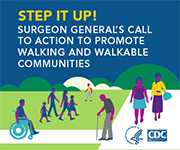Minority Health: Preventing High Blood Pressure
 A recent study shows that hospitalization due to high blood pressure is more common among African Americans. Learn what you can do to reduce your risk of developing high blood pressure.
A recent study shows that hospitalization due to high blood pressure is more common among African Americans. Learn what you can do to reduce your risk of developing high blood pressure.
High Blood Pressure Among African Americans
According to the 2010 US Census, approximately 36% of the population belongs to a racial or ethnic minority group. This February, in honor of African Heritage & Health Week, we recognize the growing minority population of the United States and address one of the most prevalent chronic diseases among African Americans.
A study published in a February 14, 2013 release of Preventing Chronic Disease (PCD) reported that minorities, particularly African Americans, have high rates of hospitalizations due to hypertension, also known as high blood pressure. In the study, researchers reported that the large gap in rates between races has been found across multiple US states, and they believe that early access to good-quality health care could help prevent these high rates of hospitalization.
Study Results
Black women had significantly higher rates of hospitalizations for high blood pressure than did white women.
Among women aged 18 to 44 in 2007–2010, whites had a hospitalization rate of 24 per 100,000 population, and blacks, 128 per 100,000 population.
Black men overall had significantly higher rates of hospitalizations for high blood pressure than did white men, a pattern similar to that seen in women.
The authors of this study believe that expanding primary prevention and early diagnosis of high blood pressure and improving high blood pressure treatment among minority populations could help prevent the high rates of hospitalizations among African Americans.

High Blood Pressure Prevention
In the United States today, about 68 million people are living with high blood pressure. The good news is that it can be prevented and controlled. The bad news is that less than half of the population with high blood pressure actually has it under control.
High blood pressure is a health concern because it can lead to heart attack and stroke, two of the leading causes of death in the United States. High blood pressure is also a major risk factor for other diseases such as congestive heart failure and kidney disease.
High blood pressure is sometimes called a "silent killer" because it often does not have any signs or symptoms. Apart from those with known high blood pressure, about 8% of US adults have hypertension but have never been diagnosed. That's why it's important to check your blood pressure regularly and to take steps to maintain normal blood pressure or lower blood pressure if it reaches unsafe levels.
Maintaining a Good Blood Pressure
There are many lifestyle changes you can make to help keep your blood pressure within a healthy range:
- Reduce your intake of salt.
- Have your blood pressure checked and then monitor it regularly.
- Maintain a healthy body weight.
- Exercise regularly.
- Eat more fruits and vegetables.
- Don't smoke.
- Watch your alcohol intake (no more than two drinks per day for men or one drink per day for women).
- If you have been prescribed blood pressure medication, take it as directed.
- If you have trouble with medication side effects, talk to your health care professional about other medications you can try.
More Information
More Information
- Vital Signs: High Blood Pressure and Cholesterol
- High Blood Pressure and Cholesterol—What You Need to Know [PODCAST – 1:19 minutes]
- Translating the Dietary Approaches to Stop Hypertension (DASH) Diet for Use in Underresourced, Urban African American Communities, 2010
- Preventable Hospitalizations for Hypertension: Establishing a Baseline for Monitoring Racial Differences in Rates
- Minority Health
- Page last reviewed: February 10, 2014
- Page last updated: February 10, 2014
- Content source:
- National Center for Chronic Disease Prevention and Health Promotion, Preventing Chronic Disease Journal
- Page maintained by: Office of the Associate Director for Communication, Digital Media Branch, Division of Public Affairs




 ShareCompartir
ShareCompartir